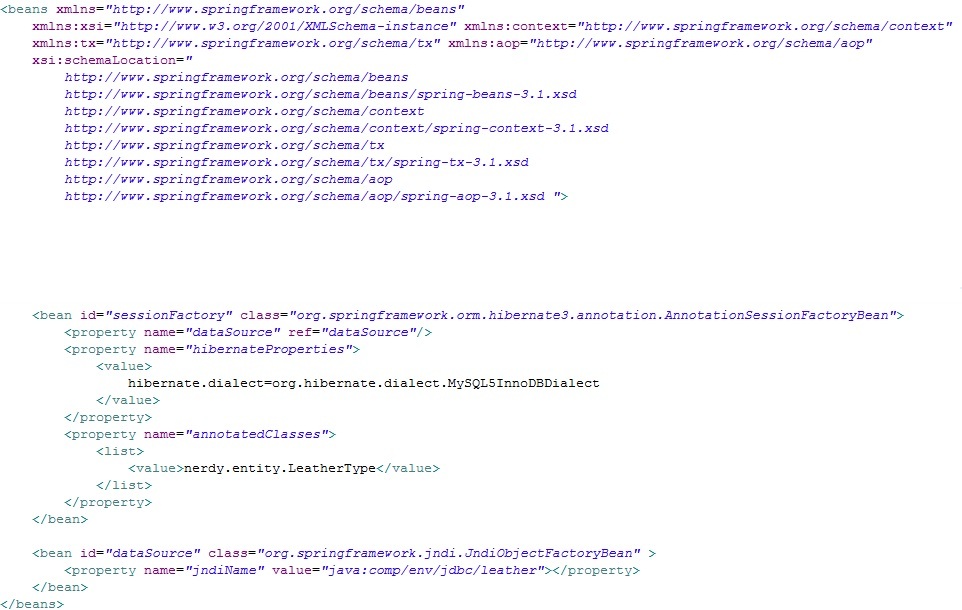如果還沒有看過Struts2 架構配置教學、Struts2+Spring架構配置教學(Spring)、Struts2+Spring+Hibernate架構配置教學(Hibernate)上、Struts2+Spring+Hibernate架構配置教學(Hibernate+JNDI)下
這四篇的人~可以先去看一下
討厭鬼的專案是從上面幾篇一步一步建出來的
如果有問題想問~或是有什麼文章想要討厭鬼po的
討厭鬼會的話~就會po出來
討厭鬼預計接下的的文章還有Struts tag的用法、Junit(Spring+Hibernate)建置及用法、jqgrid建置及用法
因為討厭鬼本身還要上班~所以可能有點慢、先跟大家說聲抱歉
那討厭鬼就開始了喔!!!!!!!!!!!!!
這一篇主要是在講說Spring的注入方式、以及如何用Hibernate去資料庫撈資料
Srping 主要的注入方式有兩種
一種是在class中加入property
並且要在class加入一個全域變數並設置應變數的setter
如下
<bean id="leatherTypeDAO" class="nerdy.entity.dao.LeatherTypeDAO">
<property name="sessionFactory" ref="sessionFactory"></property>
</bean>
public class LeatherTypeDAO {
private SessionFactory sessionFactory;
public void setSessionFactory(SessionFactory sessionFactory) {
this.sessionFactory = sessionFactory;
}
}
如此一來Spring才能將sessionFactory的值注入
缺點是加果要注入的值一多~會變的不好管理以及忘記在class中設定setter導致變數是null
另一種就是我現在用的annotation
像我現在已經在Spring中設定檔中設定了這個sessionFactory
<bean id="sessionFactory" class="org.springframework.orm.hibernate3.annotation.AnnotationSessionFactoryBean">
<property name="dataSource" ref="dataSource"/>
<property name="hibernateProperties">
<value>
hibernate.dialect=org.hibernate.dialect.MySQL5InnoDBDialect
</value>
</property>
<property name="annotatedClasses">
<list>
<value>nerdy.entity.LeatherType</value>
</list>
</property>
</bean>
那我只要在Spring的設定檔中加入<context:annotation-config/>
並且在你想要用到sessionFactory的class中加入一個全域變數並在該變數上加入@Resource就可以了
public class LeatherTypeDAO {
@Resource
private SessionFactory sessionFactory;
}
這樣的好處是很方便~Spring的設定檔不會落落長也比較好看
class中程式碼也會少一點
以下是我的範例
<?xml version="1.0" encoding="UTF-8"?>
<beans xmlns="http://www.springframework.org/schema/beans"
xmlns:xsi="http://www.w3.org/2001/XMLSchema-instance" xmlns:context="http://www.springframework.org/schema/context"
xmlns:tx="http://www.springframework.org/schema/tx" xmlns:aop="http://www.springframework.org/schema/aop"
xsi:schemaLocation="
http://www.springframework.org/schema/beans
http://www.springframework.org/schema/beans/spring-beans-3.1.xsd
http://www.springframework.org/schema/context
http://www.springframework.org/schema/context/spring-context-3.1.xsd
http://www.springframework.org/schema/tx
http://www.springframework.org/schema/tx/spring-tx-3.1.xsd
http://www.springframework.org/schema/aop
http://www.springframework.org/schema/aop/spring-aop-3.1.xsd ">
<bean id="sessionFactory" class="org.springframework.orm.hibernate3.annotation.AnnotationSessionFactoryBean">
<property name="dataSource" ref="dataSource"/>
<property name="hibernateProperties">
<value>
hibernate.dialect=org.hibernate.dialect.MySQL5InnoDBDialect
</value>
</property>
<property name="annotatedClasses">
<list>
<value>nerdy.entity.LeatherType</value>
</list>
</property>
</bean>
<bean id="dataSource" class="org.springframework.jndi.JndiObjectFactoryBean" >
<property name="jndiName" value="java:comp/env/jdbc/leather"></property>
</bean>
</beans>
而Hibernate的用法就更簡單了
在這邊我不教各位客倌在Hibernate中下SQL與HQL
因為Hibernate本來就是一個不需要會SQL的人就能用
那為什麼要學HQL呢?如果要學HQL的話~討厭鬼寧可學SQL
所以在這邊要用的是Criteria
用上面Spring注入的方式取得sessionFactory後
就可以宣告Criteria如下
Criteria criteria = sessionFactory.openSession().createCriteria(LeatherType.class);
criteria.add(Restrictions.eq("typeId", 1));
其中LeatherType.class就是你要去查詢的資料表
而要加入條件的話就用add()若有多個條件就用多少個add
typeId為LeatherType.class的欄位名稱~而非資料庫中的欄位名稱
回傳時若為多筆則用list()
若唯一時用uniqueResult()、但用uniqueResult()但回傳值為一筆以上時會報錯
以下是撈出所有LeatherType的範例
public class LeatherTypeDAO {
@Resource
private SessionFactory sessionFactory;
public List<LeatherType> doQueryLeatherTypeList() {
Criteria criteria = sessionFactory.openSession().createCriteria(
LeatherType.class);
return criteria.list();
}
}
備註
一個資料表會對應到一個entity
一個DAO只能對一個資料表做事
例如我的資料庫有leather_type這個資料表
所以我會有一個LeatherType的entity
也會有一個LeatherTypeDAO的這class
專門對leather_type這個資料表做增刪修改
雖然這個LeatherTypeDAO是可以對其它的資料表做事
但是請不要這樣做~這樣會不好管理、也會不好維護




 留言列表
留言列表
